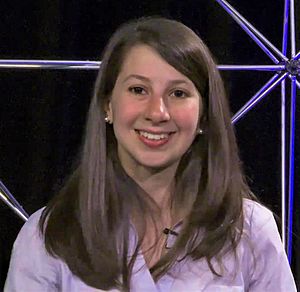Katie Bouman facts for kids
Quick facts for kids
Katie Bouman
|
|
|---|---|

Bouman speaking about the Event Horizon Telescope in 2019
|
|
| Born |
Katherine Louise Bouman
1989 (age 35–36) |
| Nationality | American |
| Alma mater | |
| Known for | CHIRP algorithm |
| Scientific career | |
| Fields | |
| Institutions | |
| Thesis | Extreme Imaging via Physical Model Inversion: Seeing Around Corners and Imaging Black Holes (2017) |
| Doctoral advisor | William T. Freeman |
Katherine Bouman, born in 1989, is an American engineer and computer scientist. She works in a field called computational imaging, which uses computers to create images.
She helped create a special computer program, called CHIRP, to take pictures of black holes. She was also part of the Event Horizon Telescope team that took the very first picture of a black hole!
In June 2019, she joined the California Institute of Technology (Caltech) as a professor. In 2020, she received a special named professorship there. An asteroid was even named after her in 2021: 291387 Katiebouman. As of 2024, she is an associate professor.
Contents
Early Life and Education
Katie Bouman grew up in West Lafayette, Indiana. Her father, Charles Bouman, is also a professor at Purdue University. He teaches electrical and computer engineering.
When she was in high school, Katie did research on imaging at Purdue University. She finished high school in 2007.
College and Graduate School
Katie studied electrical engineering at the University of Michigan. She graduated with high honors in 2011.
She then went to the Massachusetts Institute of Technology (MIT). There, she earned her master's degree in 2013. She completed her doctoral degree in electrical engineering and computer science in 2017.
At MIT, she was part of a group called the MIT Computer Science and Artificial Intelligence Laboratory (CSAIL). This group worked closely with MIT's Haystack Observatory and the Event Horizon Telescope.
Her master's project was about understanding how fabric moves. Her PhD project was about "extreme imaging," which included seeing around corners and imaging black holes. Her professor, William T. Freeman, guided her work.
Before she finished her PhD, Katie gave a TEDx talk. It was called "How to Take a Picture of a Black Hole." In this talk, she explained the computer programs that could help capture the first image of a black hole.
Research and Career
After getting her doctorate, Katie Bouman worked at Harvard University. She was a postdoctoral fellow with the Event Horizon Telescope Imaging team.

Katie joined the Event Horizon Telescope project in 2013. She led the creation of a computer program called CHIRP. This program helps create clear images from the data collected by the telescopes.
CHIRP was very important for making the first image of a black hole in April 2019. Katie helped check the images and choose the best settings for them. She also helped develop a strong system to compare different ways of making the images.
Her team is still studying the black hole images. They want to learn more about general relativity in very strong gravity.
Teamwork and Recognition
Katie Bouman received a lot of attention when a photo of her went viral. The picture showed her excited reaction when the black hole image was first seen. Some people online mistakenly thought she was the only person behind the image.
However, Katie has always said that the image was the result of a huge team effort. She emphasizes how important teamwork is in science. She also faced some unfair online attacks, but her colleagues defended her.
In June 2019, Katie joined the California Institute of Technology (Caltech) as an assistant professor. She works on new ways to use computers to create images. This includes using computer vision and machine learning.
In 2024, she was promoted to associate professor at Caltech. She also received a special professorship there in 2020. In 2021, she was given the Royal Photographic Society Progress Medal.
Awards and Honors
- In 2019, the BBC named her one of their 100 inspiring women.
- In 2024, Katie Bouman received a Sloan Research Fellowship.
See also
 In Spanish: Katie Bouman para niños
In Spanish: Katie Bouman para niños

